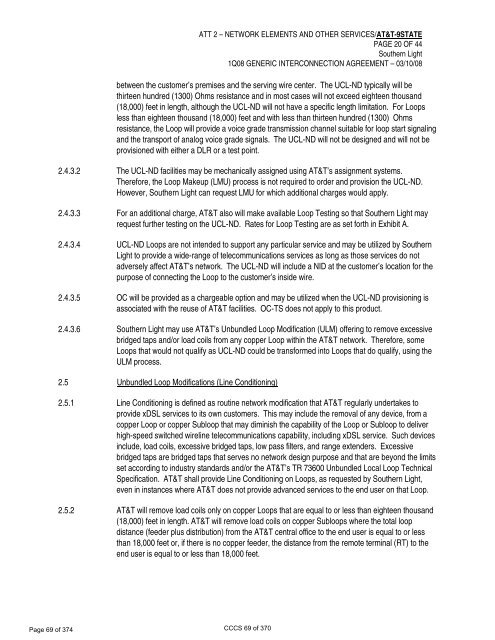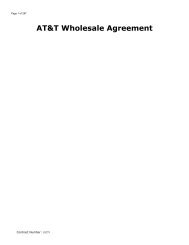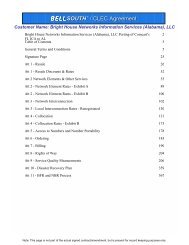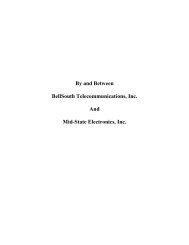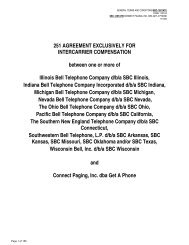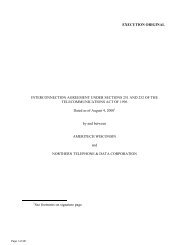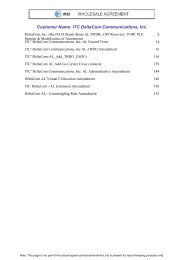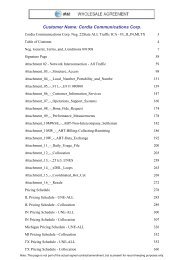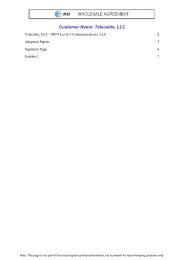- Page 1 and 2:
Southern Light - ICA 1Q08 Table of
- Page 3 and 4:
Page 3 of 374 General Terms and Con
- Page 5 and 6:
Page 5 of 374 GENERAL TERMS AND CON
- Page 7 and 8:
Page 7 of 374 2 Term of the Agreeme
- Page 9 and 10:
Page 9 of 374 GENERAL TERMS AND CON
- Page 11 and 12:
Page 11 of 374 6.3 Intellectual Pro
- Page 13 and 14:
Page 13 of 374 GENERAL TERMS AND CO
- Page 15 and 16:
Page 15 of 374 GENERAL TERMS AND CO
- Page 17 and 18: Page 17 of 374 GENERAL TERMS AND CO
- Page 19 and 20: Page 19 of 374 (251) 662-1512 pbull
- Page 21 and 22: Page 21 of 374 GENERAL TERMS AND CO
- Page 23 and 24: Page 23 of 374 CCCS 23 of 370
- Page 25 and 26: Page 25 of 374 ATT 1 - RESALE/AT&T-
- Page 27 and 28: Page 27 of 374 ATT 1 - RESALE/AT&T-
- Page 29 and 30: Page 29 of 374 ATT 1 - RESALE/AT&T-
- Page 31 and 32: Page 31 of 374 ATT 1 - RESALE/AT&T-
- Page 33 and 34: Page 33 of 374 ATT 1 - RESALE/AT&T-
- Page 35 and 36: Type of Service ATT 1 - RESALE/AT&T
- Page 37 and 38: Page 37 of 374 ATT 1 - RESALE/AT&T9
- Page 39 and 40: Page 39 of 374 ATT 1 - RESALE/AT&T9
- Page 41 and 42: RESALE DISCOUNTS & RATES - Alabama
- Page 43 and 44: RESALE DISCOUNTS & RATES - Georgia
- Page 45 and 46: RESALE DISCOUNTS & RATES - Louisian
- Page 47 and 48: RESALE DISCOUNTS & RATES - North Ca
- Page 49 and 50: RESALE DISCOUNTS & RATES - Tennesse
- Page 51 and 52: Page 51 of 374 ATT 2 - NETWORK ELEM
- Page 53 and 54: Page 53 of 374 ATT 2 - NETWORK ELEM
- Page 55 and 56: Page 55 of 374 ATT 2 - NETWORK ELEM
- Page 57 and 58: Page 57 of 374 ATT 2 - NETWORK ELEM
- Page 59 and 60: Page 59 of 374 ATT 2 - NETWORK ELEM
- Page 61 and 62: Page 61 of 374 ATT 2 - NETWORK ELEM
- Page 63 and 64: 2.1.9 SL-1 (Non- Designed) UCL-ND (
- Page 65 and 66: Page 65 of 374 2.1.13 EEL to Loop R
- Page 67: Page 67 of 374 ATT 2 - NETWORK ELEM
- Page 71 and 72: Page 71 of 374 ATT 2 - NETWORK ELEM
- Page 73 and 74: Page 73 of 374 ATT 2 - NETWORK ELEM
- Page 75 and 76: Page 75 of 374 ATT 2 - NETWORK ELEM
- Page 77 and 78: Page 77 of 374 ATT 2 - NETWORK ELEM
- Page 79 and 80: Page 79 of 374 ATT 2 - NETWORK ELEM
- Page 81 and 82: Page 81 of 374 ATT 2 - NETWORK ELEM
- Page 83 and 84: Page 83 of 374 ATT 2 - NETWORK ELEM
- Page 85 and 86: Page 85 of 374 ATT 2 - NETWORK ELEM
- Page 87 and 88: Page 87 of 374 ATT 2 - NETWORK ELEM
- Page 89 and 90: Page 89 of 374 ATT 2 - NETWORK ELEM
- Page 91 and 92: Page 91 of 374 ATT 2 - NETWORK ELEM
- Page 93 and 94: Page 93 of 374 ATT 2 - NETWORK ELEM
- Page 95 and 96: UNBUNDLED NETWORK ELEMENTS - Alabam
- Page 97 and 98: UNBUNDLED NETWORK ELEMENTS - Alabam
- Page 99 and 100: UNBUNDLED NETWORK ELEMENTS - Alabam
- Page 101 and 102: UNBUNDLED NETWORK ELEMENTS - Alabam
- Page 103 and 104: UNBUNDLED NETWORK ELEMENTS - Alabam
- Page 105 and 106: UNBUNDLED NETWORK ELEMENTS - Florid
- Page 107 and 108: UNBUNDLED NETWORK ELEMENTS - Florid
- Page 109 and 110: UNBUNDLED NETWORK ELEMENTS - Florid
- Page 111 and 112: UNBUNDLED NETWORK ELEMENTS - Florid
- Page 113 and 114: UNBUNDLED NETWORK ELEMENTS - Florid
- Page 115 and 116: UNBUNDLED NETWORK ELEMENTS - Georgi
- Page 117 and 118: UNBUNDLED NETWORK ELEMENTS - Georgi
- Page 119 and 120:
UNBUNDLED NETWORK ELEMENTS - Georgi
- Page 121 and 122:
UNBUNDLED NETWORK ELEMENTS - Georgi
- Page 123 and 124:
UNBUNDLED NETWORK ELEMENTS - Georgi
- Page 125 and 126:
UNBUNDLED NETWORK ELEMENTS - Kentuc
- Page 127 and 128:
UNBUNDLED NETWORK ELEMENTS - Kentuc
- Page 129 and 130:
UNBUNDLED NETWORK ELEMENTS - Kentuc
- Page 131 and 132:
UNBUNDLED NETWORK ELEMENTS - Kentuc
- Page 133 and 134:
UNBUNDLED NETWORK ELEMENTS - Kentuc
- Page 135 and 136:
UNBUNDLED NETWORK ELEMENTS - Kentuc
- Page 137 and 138:
UNBUNDLED NETWORK ELEMENTS - Louisi
- Page 139 and 140:
UNBUNDLED NETWORK ELEMENTS - Louisi
- Page 141 and 142:
UNBUNDLED NETWORK ELEMENTS - Louisi
- Page 143 and 144:
UNBUNDLED NETWORK ELEMENTS - Louisi
- Page 145 and 146:
UNBUNDLED NETWORK ELEMENTS - Louisi
- Page 147 and 148:
UNBUNDLED NETWORK ELEMENTS - Missis
- Page 149 and 150:
UNBUNDLED NETWORK ELEMENTS - Missis
- Page 151 and 152:
UNBUNDLED NETWORK ELEMENTS - Missis
- Page 153 and 154:
UNBUNDLED NETWORK ELEMENTS - Missis
- Page 155 and 156:
UNBUNDLED NETWORK ELEMENTS - Missis
- Page 157 and 158:
UNBUNDLED NETWORK ELEMENTS - Missis
- Page 159 and 160:
UNBUNDLED NETWORK ELEMENTS - North
- Page 161 and 162:
UNBUNDLED NETWORK ELEMENTS - North
- Page 163 and 164:
UNBUNDLED NETWORK ELEMENTS - North
- Page 165 and 166:
UNBUNDLED NETWORK ELEMENTS - North
- Page 167 and 168:
UNBUNDLED NETWORK ELEMENTS - North
- Page 169 and 170:
UNBUNDLED NETWORK ELEMENTS - North
- Page 171 and 172:
UNBUNDLED NETWORK ELEMENTS - South
- Page 173 and 174:
UNBUNDLED NETWORK ELEMENTS - South
- Page 175 and 176:
UNBUNDLED NETWORK ELEMENTS - South
- Page 177 and 178:
UNBUNDLED NETWORK ELEMENTS - South
- Page 179 and 180:
UNBUNDLED NETWORK ELEMENTS - South
- Page 181 and 182:
UNBUNDLED NETWORK ELEMENTS - Tennes
- Page 183 and 184:
UNBUNDLED NETWORK ELEMENTS - Tennes
- Page 185 and 186:
UNBUNDLED NETWORK ELEMENTS - Tennes
- Page 187 and 188:
UNBUNDLED NETWORK ELEMENTS - Tennes
- Page 189 and 190:
UNBUNDLED NETWORK ELEMENTS - Tennes
- Page 191 and 192:
UNBUNDLED NETWORK ELEMENTS - Alabam
- Page 193 and 194:
UNBUNDLED NETWORK ELEMENTS - Florid
- Page 195 and 196:
UNBUNDLED NETWORK ELEMENTS - Georgi
- Page 197 and 198:
UNBUNDLED NETWORK ELEMENTS - Kentuc
- Page 199 and 200:
UNBUNDLED NETWORK ELEMENTS - Louisi
- Page 201 and 202:
UNBUNDLED NETWORK ELEMENTS - Missis
- Page 203 and 204:
UNBUNDLED NETWORK ELEMENTS - South
- Page 205 and 206:
UNBUNDLED NETWORK ELEMENTS - Tennes
- Page 207 and 208:
Page 207 of 374 ATT 3 - NETWORK INT
- Page 209 and 210:
Page 209 of 374 1 General ATT 3 - N
- Page 211 and 212:
Page 211 of 374 ATT 3 - NETWORK INT
- Page 213 and 214:
Page 213 of 374 ATT 3 - NETWORK INT
- Page 215 and 216:
Page 215 of 374 ATT 3 - NETWORK INT
- Page 217 and 218:
Page 217 of 374 ATT 3 - NETWORK INT
- Page 219 and 220:
Page 219 of 374 ATT 3 - NETWORK INT
- Page 221 and 222:
Page 221 of 374 ATT 3 - NETWORK INT
- Page 223 and 224:
Page 223 of 374 ATT 3 - NETWORK INT
- Page 225 and 226:
Page 225 of 374 ATT 3 - NETWORK INT
- Page 227 and 228:
Page 227 of 374 AT&T EO 1 - way loc
- Page 229 and 230:
Page 229 of 374 AT&T EO 2 - way loc
- Page 231 and 232:
LOCAL INTERCONNECTION - Alabama CAT
- Page 233 and 234:
LOCAL INTERCONNECTION - Georgia CAT
- Page 235 and 236:
LOCAL INTERCONNECTION - Louisiana C
- Page 237 and 238:
LOCAL INTERCONNECTION - North Carol
- Page 239 and 240:
LOCAL INTERCONNECTION - Tennessee C
- Page 241 and 242:
Page 241 of 374 ATT 4 - COLLOCATION
- Page 243 and 244:
Page 243 of 374 ATT 4 - COLLOCATION
- Page 245 and 246:
Page 245 of 374 ATT 4 - COLLOCATION
- Page 247 and 248:
Page 247 of 374 ATT 4 - COLLOCATION
- Page 249 and 250:
Page 249 of 374 ATT 4 - COLLOCATION
- Page 251 and 252:
Page 251 of 374 ATT 4 - COLLOCATION
- Page 253 and 254:
Page 253 of 374 ATT 4 - COLLOCATION
- Page 255 and 256:
Page 255 of 374 ATT 4 - COLLOCATION
- Page 257 and 258:
Page 257 of 374 ATT 4 - COLLOCATION
- Page 259 and 260:
Page 259 of 374 ATT 4 - COLLOCATION
- Page 261 and 262:
Page 261 of 374 ATT 4 - COLLOCATION
- Page 263 and 264:
Page 263 of 374 ATT 4 - COLLOCATION
- Page 265 and 266:
Page 265 of 374 ATT 4 - COLLOCATION
- Page 267 and 268:
Page 267 of 374 ATT 4 - COLLOCATION
- Page 269 and 270:
Page 269 of 374 ATT 4 - COLLOCATION
- Page 271 and 272:
Page 271 of 374 ATT 4 - COLLOCATION
- Page 273 and 274:
Page 273 of 374 ATT 4 - COLLOCATION
- Page 275 and 276:
Page 275 of 374 ATT 4 - COLLOCATION
- Page 277 and 278:
Page 277 of 374 ATT 4 - COLLOCATION
- Page 279 and 280:
Page 279 of 374 ATT 4 - COLLOCATION
- Page 281 and 282:
Page 281 of 374 ATT 4 - COLLOCATION
- Page 283 and 284:
Page 283 of 374 ATT 4 - COLLOCATION
- Page 285 and 286:
COLLOCATION - Alabama CATEGORY RATE
- Page 287 and 288:
COLLOCATION - Alabama CATEGORY RATE
- Page 289 and 290:
COLLOCATION - Florida CATEGORY RATE
- Page 291 and 292:
COLLOCATION - Florida CATEGORY RATE
- Page 293 and 294:
COLLOCATION - Florida CATEGORY RATE
- Page 295 and 296:
COLLOCATION - Georgia CATEGORY RATE
- Page 297 and 298:
COLLOCATION - Georgia CATEGORY RATE
- Page 299 and 300:
COLLOCATION - Kentucky CATEGORY RAT
- Page 301 and 302:
COLLOCATION - Kentucky CATEGORY RAT
- Page 303 and 304:
COLLOCATION - Kentucky CATEGORY RAT
- Page 305 and 306:
COLLOCATION - Louisiana CATEGORY RA
- Page 307 and 308:
COLLOCATION - Louisiana CATEGORY RA
- Page 309 and 310:
COLLOCATION - Mississippi CATEGORY
- Page 311 and 312:
COLLOCATION - Mississippi CATEGORY
- Page 313 and 314:
COLLOCATION - Mississippi CATEGORY
- Page 315 and 316:
COLLOCATION - North Carolina CATEGO
- Page 317 and 318:
COLLOCATION - North Carolina CATEGO
- Page 319 and 320:
COLLOCATION - South Carolina CATEGO
- Page 321 and 322:
COLLOCATION - South Carolina CATEGO
- Page 323 and 324:
COLLOCATION - South Carolina CATEGO
- Page 325 and 326:
COLLOCATION - Tennessee CATEGORY RA
- Page 327 and 328:
COLLOCATION - Tennessee CATEGORY RA
- Page 329 and 330:
Page 329 of 374 ATT 5 - ACCESS TO N
- Page 331 and 332:
Page 331 of 374 ATT 5 - ACCESS TO N
- Page 333 and 334:
Page 333 of 374 ATT 5 - ACCESS TO N
- Page 335 and 336:
Page 335 of 374 ATT 6 - PRE-ORDERIN
- Page 337 and 338:
Page 337 of 374 ATT 6 - PRE-ORDERIN
- Page 339 and 340:
Page 339 of 374 ATT 6 - PRE-ORDERIN
- Page 341 and 342:
Page 341 of 374 ATT 6 - PRE-ORDERIN
- Page 343 and 344:
Page 343 of 374 ATT 7 - BILLING/AT&
- Page 345 and 346:
Page 345 of 374 ATT 7 - BILLING/AT&
- Page 347 and 348:
Page 347 of 374 ATT 7 - BILLING/AT&
- Page 349 and 350:
Page 349 of 374 ATT 7 - BILLING/AT&
- Page 351 and 352:
Page 351 of 374 ATT 7 - BILLING/AT&
- Page 353 and 354:
Page 353 of 374 ATT 8 - RIGHTS-OF-W
- Page 355 and 356:
Page 355 of 374 ATT 9 - SERVICE QUA
- Page 357 and 358:
Page 357 of 374 1.0 PURPOSE ATT 10
- Page 359 and 360:
Page 359 of 374 3.2 ENVIRONMENTAL C
- Page 361 and 362:
Page 361 of 374 5.2.1 Loss of a CO
- Page 363 and 364:
Page 363 of 374 7.0 ACRONYMS CLEC -
- Page 365 and 366:
Page 365 of 374 ATT 11 - BONA FIDE
- Page 367 and 368:
Page 367 of 374 ATT 11 - BONA FIDE
- Page 369 and 370:
Page 369 of 374 ATT 11 - BONA FIDE
- Page 371 and 372:
Page 1 of 4 Contract Number: 8931 P
- Page 373 and 374:
Page 3 of 4 Page 373 of 374 AMENDME


